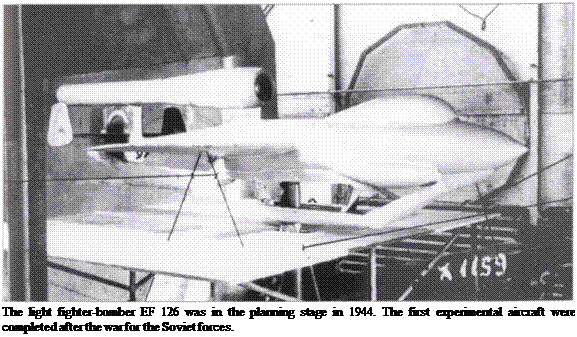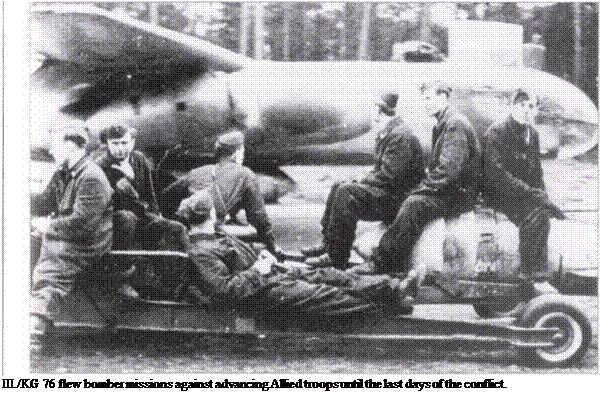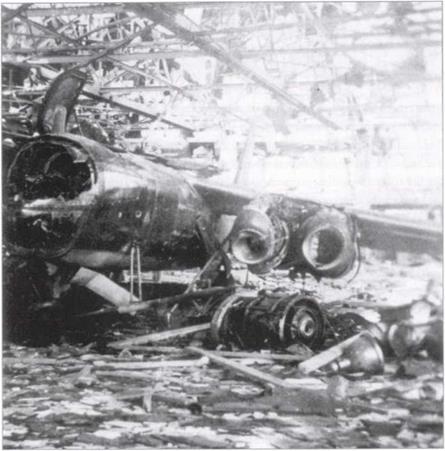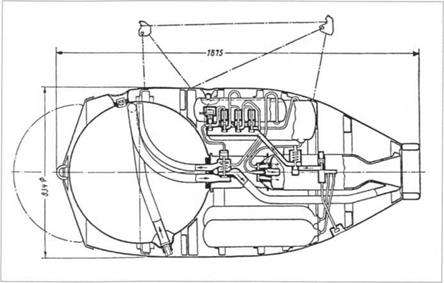Final Operations of the Bomber Geschwader
 |
The deployment of the much faster twin-jet Ar 234 В-2 which became operational in reasonable numbers from the end of 1944 was seen as an important step forward. The first unit to be equipped with the Arado bomber,
|
KG 76 was the only Luftwaffe bomber formation to receive the twin-jet Ar 234 B-2 bomber, using it in action from late December 1944. |
III./KG 76, received its first Ar 234 B-2 on 28 August 1944. Led by Knights Cross holder Hauptmann Diether Lukesch, conversion training took place at Burg near Magdeburg, and the first operation was flown on 23 December by the operational flight Kommando Lukesch. Once 9. Staffel at Miinster-Handorf began working as the operational test unit, operational preparations began for 7. and 8. Staffeln. III./KG 76 had 21 bombers in December 1944. Its first attack was made on Verviers town centre when six aircraft came in at low level and dropped SC 500 bombs to commence Ar 234 operations in the West. On 24 January III./KG 76 was placed at the disposal of IL/Jagdkorps, while other elements of the Geschwader were transferred to Achmer. Over the airfield the German jet bombers were attacked by aircraft of 401 Squadron RAF, two Ar 234s being shot down. As other machines landed they were attacked by low – flying aircraft, a third bomber exploding and a fourth being seriously damaged by machine-gun fire. Not until 8 February did III./KG 76 begin operations from Achmer on a large scale. The original plan was to attack the Brussels marshalling yard with SC 500 bombs but the unfavourable weather forced the bombers to go for the alternative railway installations at Charleroi and two other stations. Because of Allied low-level attacks and bad weather, flying was much restricted until 14 February, when the targets were near Eindhoven and Kleve.
On 21 February Knight’s Cross holder Oberstleutnant Robert Kowaleski, KG 76 Kommodore, was tasked with setting up a Gefechtsverband joining together Stabsstaffel/KG 76 (Ar 234), 6., 8. and 9. Staffeln (Ar 234) plus I. and
II./KG 51 (Me 262) into a powerful high-performance jet-bomber unit for the first time. That day Major Hansgeorg Batcher led a raid dropping SD 500 bombs on Allied positions in north-western Germany: 21 Ar 234 В-2s launched heavy attacks against troop formations between Eindhoven and Kleve. Around 24 hours later, nine Ar 234s bombed American ground forces south and north-east of Aachen. Attacks on Allied positions and airfields continued throughout February.
In early March the Allied advance in the West picked up. On the early morning of 7 March the first Sherman tank of US 9th Armored Division reached the Rhine and, since the defenders had failed to demolish the Ludendorff bridge at Remagen, it soon fell into American hands. KG 76 received orders to destroy the structure immediately at whatever cost, but bad weather kept aircraft grounded until 8 March, allowing the Americans to establish their bridgehead and reinforce it with heavy AA batteries.

Ar 234 B-2 jets attacked the Ludendorff bridge for the first time on 9 March. Oberfeldwebel Friedrich Bruchlos (Wks No. 140589 F14AS) drew the entire concentration of light AA fire on himself in a low-level pass at 400 metres. A
li
V

turbine caught fire and began trailing smoke, and his aircraft was soon overtaken by Allied fighters and shot down 15 kilometres from the bridge at Fockenbachtal north of Neuwied. The other two pilots were also unsuccessfiil.
The next attacks followed on 11 March when two Ar 234 B-2s were unsuccessful, and on 12 March at midday two machines of the Geschwaderstab and two from 6. Staffel headed for the now very heavily defended bridge. Hauptmann Hirschberger and Fahnenjunker-Feldwebel Riemensperger, leading the first operation by 6./KG 76, approached the target with auto-pilot engaged at 8,000 metres in level flight. Short of Remagen Riemensperger took over manual control and dropped his bomb. Then he noticed the Staffelkapitan sitting motionless in his cabin, his bomb still slung beneath the fuselage. The ensign bore away for base at Achmer. When the fuel in Hirschberger’s Ar 234 ran out, he crashed near Lyons. Another attack on the bridge by 14 Ar 234s followed a little later. Using the accurate Egon equipment, SC 1000 bombs were dropped from 5,000 metres altitude but without success. On 13 March seven Ar 234 B-2s of 6./KG 76 each carried a one-tonne bomb to the target. One flight released its SC 1000 bombs in a gliding approach, the others using Egon from 5,000 metres. III./KG 76 also attacked Remagen with 12 bombers, and six 6./KG 76 pilots tried a little later, but the bridge held.
The Allies now took counter-measures. Fighters attacked the jet bombers at Achmer on take-off and pursued them to Remagen where the AA took its toll.
![]()
A number of German aircraft were hit by fire from the principal bridge and pontoon crossings over the Rhine and crashed. After the bridge was unexpectedly demolished on 17 March, Gefechtsverband Kowaleski operational staff removed all its machines to well-developed aerodromes in southern Germany on 19 March from where they could attack Alsace and Rhine-Hesse, the starting points for the American advance on Mainz. Part of KG 76 operated from Miinster – Osnabriick. The KG 76 airfields in this region now received the attentions of USAF bombers, 12 B-24s being sent to destroy Achmer airfield and 13 others to Hesepe.
On 28 March large Allied armoured formations began their attempt to force a route to the Westphalian plain. The following evening Ar 234 bombers of III./KG 76 attacked targets in the west. Four pilots dropped their bombs on American armoured positions along the River Nahe between Sobernheim and Bad Kreuznach. As the threat to the KG 76 airfields near Osnabriick from low flying Allied fighters and bombers became more severe, a move northward by the squadron remnants became unavoidable. On 1 April 6./KG 76 from Hesepe landed at Reinsehlen on Liineburg Heath after a refuelling stop.
Meanwhile the number of available jet bombers had fallen to ten. Despite the situation, on 2 April six pilots of III. Gruppe made gliding attacks on rewarding columns of lorries 10 kilometres south-east of Rheine, their earlier airfield, without loss to themselves. The rapidity of the Allied advance forced the Stab and three Staffeln to transfer to Kaltenkirchen north of Hamburg on 5 April, from where further sorties were flown against the Munster area. On 9 April, despite the grave fuel situation, the number of machines at KG 76 had risen to 17. Some Ar 234 B-2s arrived unexpectedly by road. Next day a number of bombers from Kaltenkirchen attacked convoys of Allied lorries on the Autobahn between Bad Oeynhausen and Hannover. Attacks were flown from a long stretch of Autobahn at Blankensee near Liibeck against the bridgehead at Essel, north of Nienburg, and to demolish bridges at Celle, particularly the Autobahn over the River Aller.
On the morning of 15 April, pilots of KG 76 attacked an Allied armoured column on the Autobahn between Brunswick and Hannover with visible success. Allied air superiority was now evidendy greater than it had been just a few weeks previously. More and more fighters operated over the ever-shrinking area which remained under German control. Losses therefore rose. The daily numbers of available jet bombers declined rapidly. An operational Gruppe for these was set up at Blankensee. Once the Red Army had begun its encirclement of Berlin, this unit concentrated on bombing raids around the capital. The Kommodore alone flew eight missions against Soviet tanks; previously he had flown seven sorties with other pilots against forces besieging the Ruhr.
On 19 April after a bombing mission to the south of Berlin, Major Polletin was killed. The following day Baruth, Zossen and Jiiterbog were bombed, and on the 25th 9./KG 76 attacked a bridge close to the centre of Berlin. After releasing his SD 500, one pilot headed for Oranienburg east of Berlin to reconnoitre where he saw large Red Army formations. On 26 April two Ar 234 В-2 bombers of the Geschwaderstab took off from Kaltenkirchen and attacked Soviet tanks at the Halleschen Tor, the very centre of the ruined Reich capital. Oberfeldwebel Breme looked down on a Berlin where many great fires raged, the city already partially occupied by the enemy. There was so much smoke from these fires, particularly around the Halleschen Tor, that it was impossible to make out Soviet tanks or other useful targets.
On 27 April the last serviceable Ar 234 B-2s were flown to Leek, from where, despite the dwindling tactical opportunities, orders from Hitler stipulated that Berlin was the target. On the 29th, the Geschwaderstab hit an armoured column
|
The production of the Ar 234 B-2 and C-3 was disrupted increasingly by Allied air attacks. In an attack on Wesendorf this bomber was written off while under construction. |
|
The Ar 234 could be fitted with rocket boosters like the Walter (HWK) 109-501 under the fuselage or wings to assist take off. |
in the Berlin battle zone. At midday on the 30th KG 76 pilots flew direcdy over the burning city centre with orders to lend support to the defenders in the government district and on the streets near the Reich Chancellery. Since this was not a promising project, attention was focused next on strongpoints closer to the home airfield. On 2 May a 9./KG 76 pilot dropped an SC 500 amidst a British armoured column approaching Liibeck on the Autobahn. On his return he was intercepted by several RAF Tempests and then came under heavy AA fire, but his superior speed enabled him to make good his escape.
Besides III. Gruppe, only II./KG 76 was close to being operational but had to complete the remainder of training. On 10 April USAF bombers attacked the unit’s airfields at Brandenburg-Briest, Burg and Zerbst with 372 B-17s; 147 of this formation wiped out Burg aerodrome. This put an end to II. Gruppe conversion training. The runway was out of commission for some considerable time. At the beginning of April, Alt-Lonnewitz came under threat from the Red Army. II. Gruppe and the Geschwaderstab transferred on 2 May from Liibeck to Schleswig, where there was sufficient fuel and provisions despite the danger of low-level attack, and from there to Rendsburg, where they eventually gave in.
The training of IV. Gruppe, intended to become III./EKG 1, a jet bomber operational training unit, was also broken off short. Between 1 and 20 February a number of III./EKG 1 crews under training carried out bombing missions against Schwedt on the Oder and at Stettin in the attempt to weaken the Soviet
advance. They flew fifteen He 111 H-20s loaned by other units. Whatever they achieved was a mere pinprick in the side of the Red Army.













